2023 Image of Research Winners & Honorable Mentions
Introduction Heading link
For 2023, the portal to submit entries opened on January 31st and closed on February 28th. During that period, 10 moving image and 65 still image entries were submitted. The members of the jury completed the first round of voting on April 17th and the top scoring entries by division and category moved on to the second round. 30 finalists were carefully evaluated in the UIC Electronic Visualization Lab and after 4 hours of deliberation, the honorable mentions and winners were selected.
1st Place - Still Image Heading link
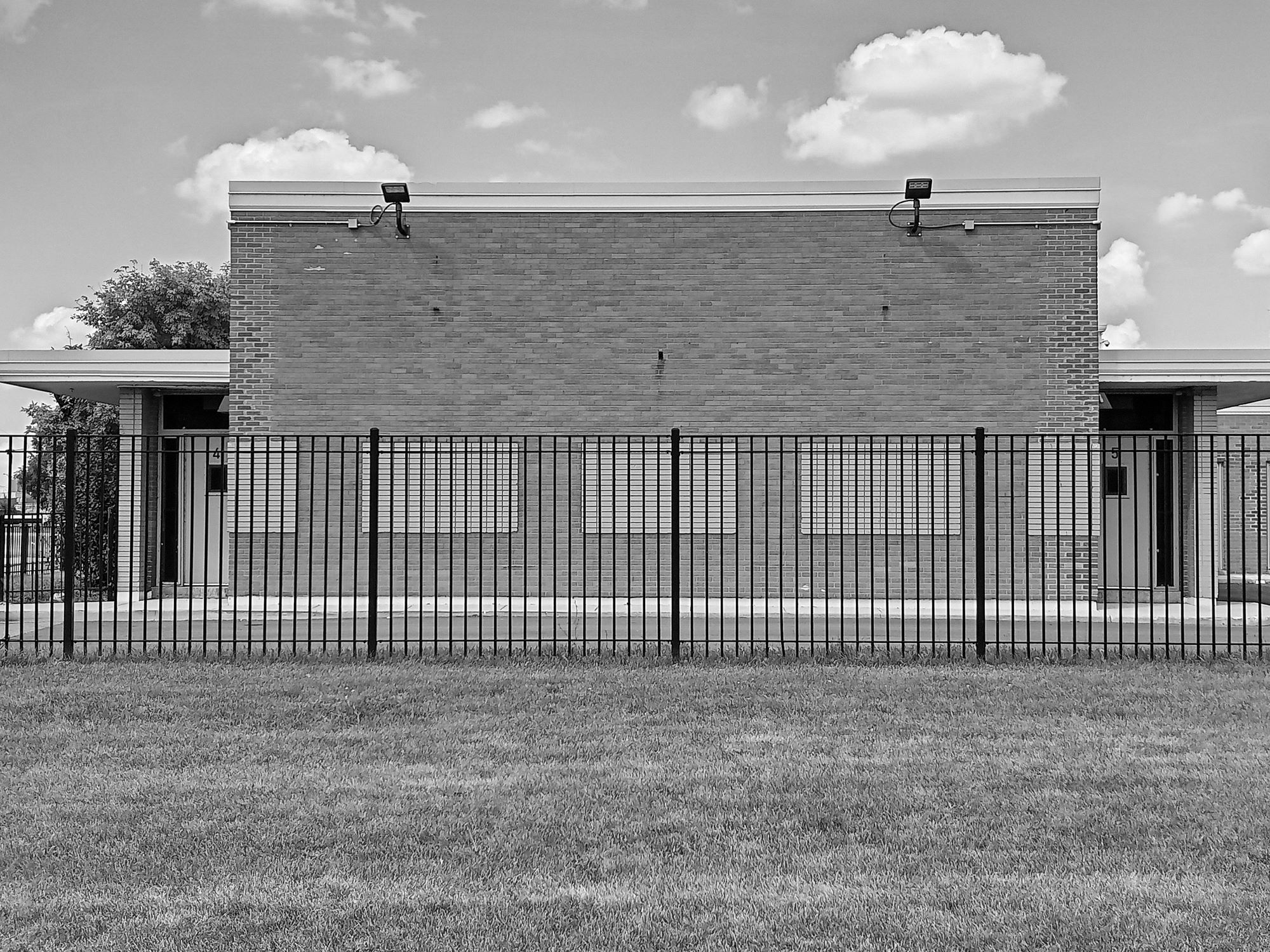
East Facade
Name: Kristy Ulrich Papczun
Program: Curriculum Studies
Division: BEHAVIORAL AND SOCIAL SCIENCES
Description: My research aims to historicize school sites where schools have been closed and reopened. I work to restory the narratives I find in the archives and gather from community members with collective remembering strategies. Using a critical perspective, this work honors and examines the “absent-presence” (Ferguson & Nichols, 2021; Gordon, 2008) of closed schools in Chicago. This site image shows a school building that used to be a neighborhood school for the surrounding public housing in Cabrini-Green until it was closed in 2009 and reopened as a selective enrollment school. The large green lawns adjacent to the school serve as scars where the public housing towers once stood, but only if one knows the site’s history. The benign nature of this photograph betrays the contested history of the site that I argue is masked over when schools are closed. Noting the unsettling symmetry and lacking any distinct identifiers, this image could stand in to represent any of the hundreds of neighborhood schools in Chicago that have been closed. Throughout my research, I use the methodology of portraiture, including images like this, to have conversations about school closings as a way to reconsider how the past is always present.
2nd Place - Still Image Heading link
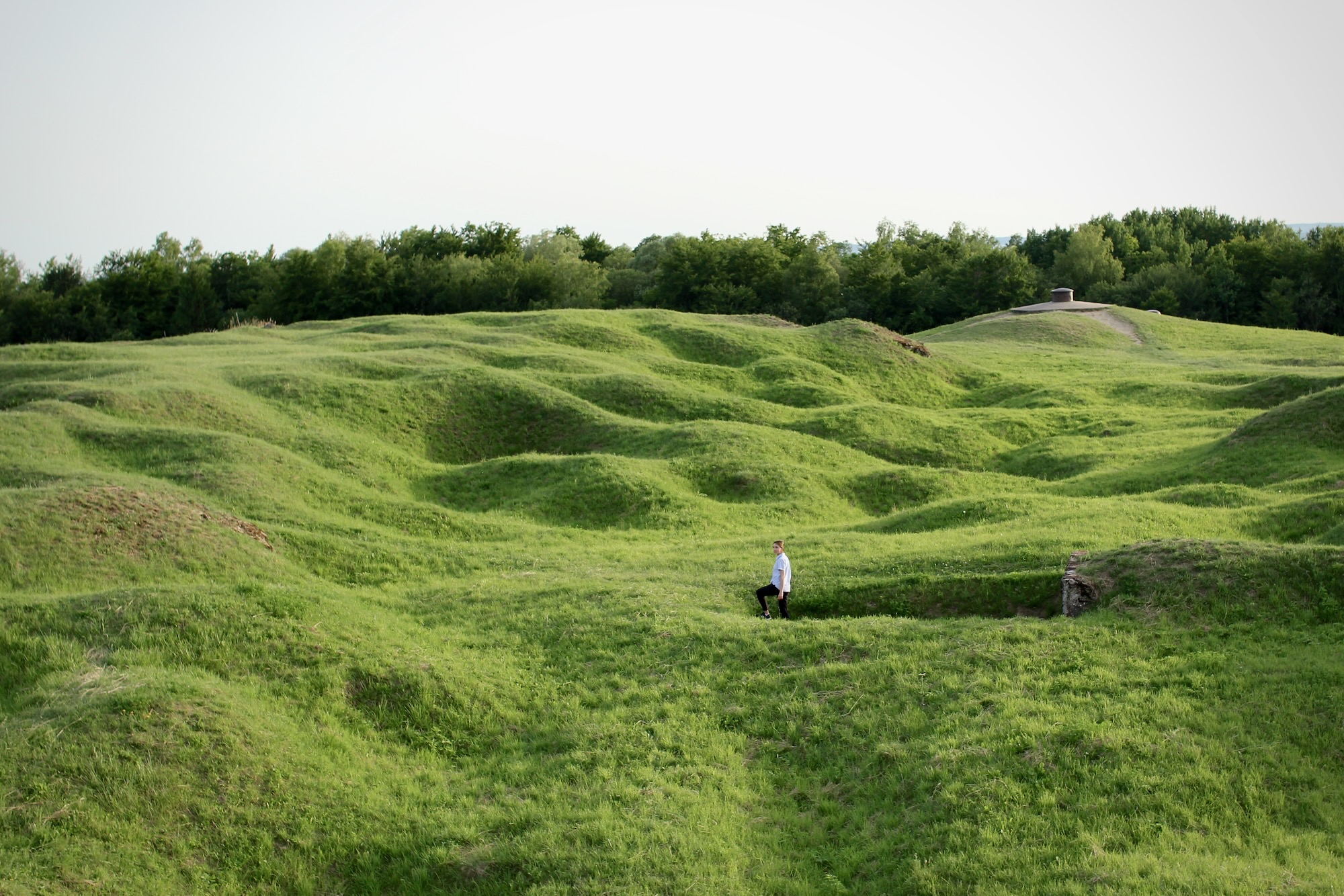
Verdun Battlefield
Name: Haylie Van Den Berghe
Program: French and Francophone Studies
Division: FINE ARTS AND HUMANITIES
Description: My graduate research focuses on reactions to World War I in French literature, examining nationalism/patriotism, disillusionment, trauma of soldiers, and lasting effects on French society. In June of 2022, I spent a week visiting various WWI battle sites and museums in France to supplement my research. The image I’m submitting depicts a battle site in Verdun, France, which was the longest battle and one of the bloodiest of WWI. I am seen emerging from a military bunker, which is completely defaced by the countless shell craters, creating an eerie moonscape of what was once flat forested ground. To me, this image represents the reactions to and the aftermath of WWI—this war completely changed the world, creating a stark opening to the 20th century, leaving behind the idyllic past of the 19th century.
3rd Place - Still Image Heading link
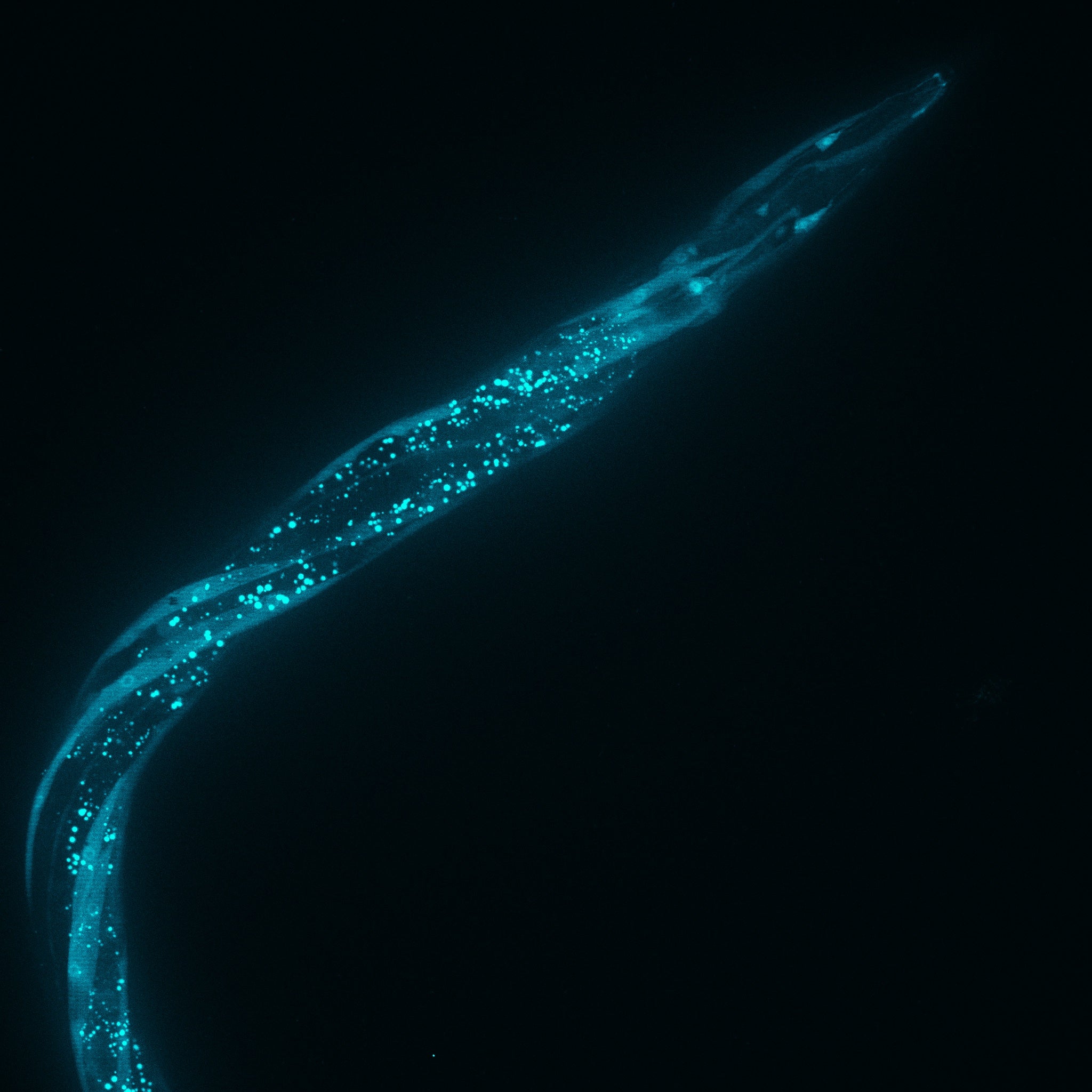
living
Name: Mushaine Shih
Program: Biological Sciences
Division: LIFE SCIENCES
Description: The increased number of the aging human population gives rise to increased disease susceptibility. A significant focus of our research is to uncover mechanisms that regulate the aging process in neurons. Recent findings of neurodegeneration highlighted the importance of post-transcriptional gene regulation, including those controlled by RNA binding proteins (RBPs). Because RBPs are critical regulators of gene expressions in the nervous system, we seek to understand the role of conserved RBPs in maintaining neuronal structural integrity in adult Caenorhabditis elegans. The transparency of the animal’s body enables us to perform live imaging to visualize the gene activity. I fluorescently tagged one of the conserved RBPs we found to play critical roles in neurodegeneration using the CRISPR technique, allowing us to perform quantitative analysis under different mutant backgrounds. The image displays RBP expression in the head neurons and spindle-shaped muscle cells wrapped around the body. With this application, we aim to elucidate mechanisms by which RBP controls age-related neurodegeneration and could provide novel mechanistic insights into the regulatory process of neurodegeneration that has not been characterized before.
Honorable Mention - Still Image Heading link

Immunological boot camp: firing up antitumor immunity
Name: Dahee Jung
Program: Pharmaceutical Sciences
Division: LIFE SCIENCES
Description: In the past few decades, researchers have discovered that each individual’s tumor has unique antigen; therefore, to effectively combat cancer, treatments need to be highly personalized. Cancer cells have specific targets called neoantigens that are only found in tumor cells due to mutations. By identifying neoantigens from a patient’s tumor, it is possible to create personalized neoantigen peptide cancer vaccines that educate the immune system to attack cancer cells. However, it’s been a challenge to effectively deliver the peptides to immune cells and evoke sufficient immune reactions. To address this, I am developing an antibody-based vaccine carrier that can efficiently deliver peptides to specific immune cells while evoking enough immune responses in lymph nodes, which are a hub for immunity. By using an agonistic CD40 antibody, I aim to target and activate dendritic cells in the lymph node. This image represents the dye-conjugated CD40 antibody distribution in the mouse lymph node after the subcutaneous injection. We observed that the s.c. injected CD40 antibody (Green) rapidly moves into the nearest lymph node and binds to dendritic cells (Red). Further, we will load the antigenic peptide to the CD40 antibody carrier to test the cancer vaccine efficiency.
Honorable Mention - Still Image Heading link
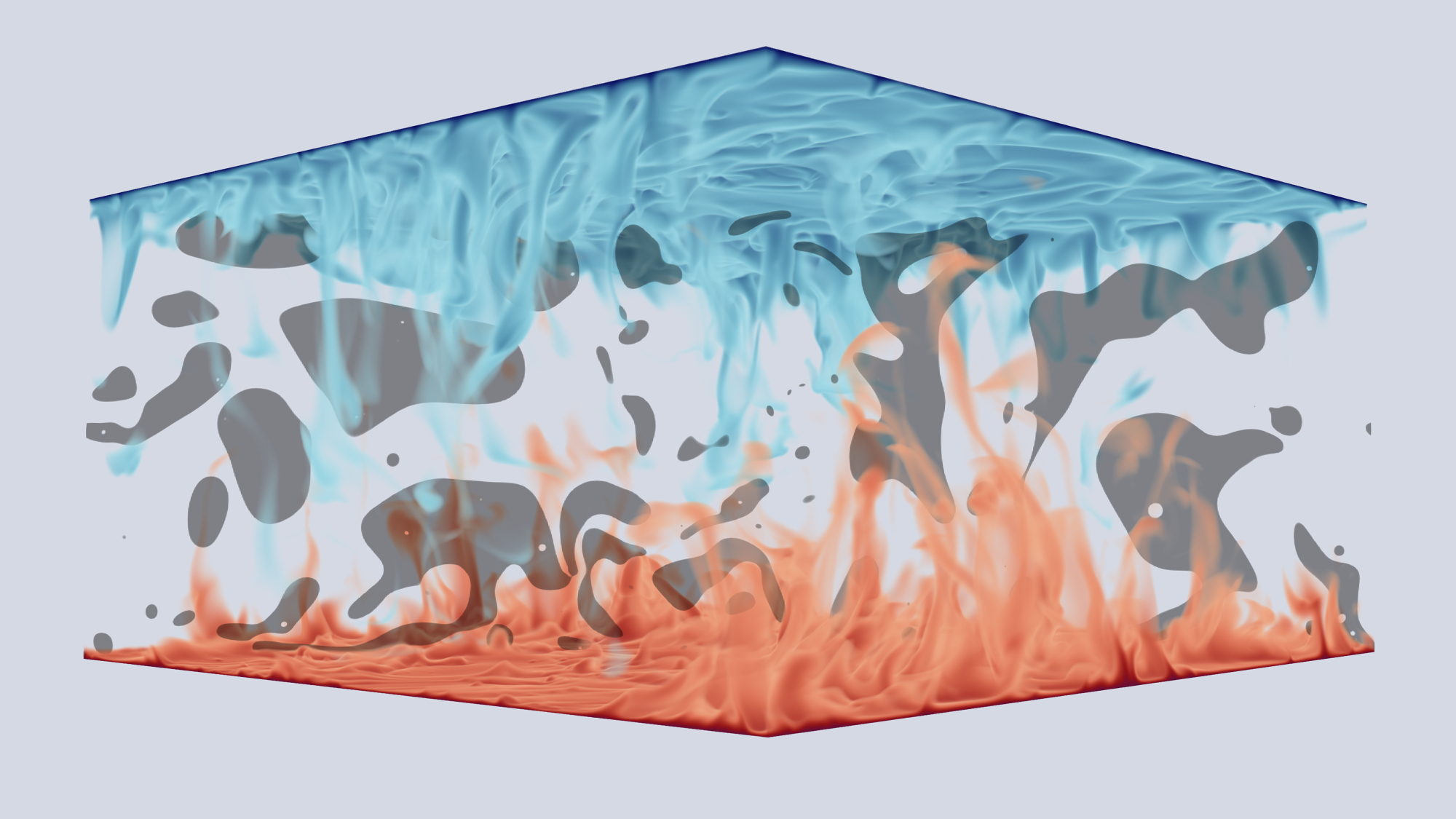
Visualizing Bubbles Within a Rayleigh Bénard Convection
Name: Hal Brynteson, Abbas Moradi Bilondi
Program: Computer Science
Division: ENGINEERING, MATHEMATICS AND PHYSICAL SCIENCES
Description:
The Rayleigh Bénard convection, where a fluid is heated from below and cooled from above, is an important mechanism of mass and heat transfer in nature and in numerous industrial applications. One can cite geophysics, astrophysics, meteorology, heat exchangers, multilayer walls in buildings and cooling of electronic components for example. In the present work, by considering bubbles inside the fluid flow, we aim to investigate the effects of the presence of bubbles on the heat transfer rate. In this visualization, bubbles are shown in between the shifting temperatures, rendered as a volume. Fluid simulation by Abbas Moradi Bilondi and visualization by Hal Brynteson.
Honorable Mention - Still Image Heading link
Bursting into Life
Name: Yahya Najjar
Program: Biological Sciences
Division: LIFE SCIENCES
Description: A 2-day-old leaf of an Arabidopsis thaliana (Thale cress) plant, grown in total darkness, was imaged after its initial emergence. When a plant is ready to emerge from the soil, water is absorbed into the seed. This expands the seed and helps the young leaves to push through the soil toward the surface. Young leaves fight their way out of the seed, bursting through the seams, desperately chasing the source of light. Due to this initial expansion, what is left is a beautiful shimmering and fiery seed coat. This image was captured using a Zeiss deconvoluting microscope (Observer Z.1 Excite 120LED). UV, blue-green, and orange-red LEDs were directed at the live leaf for less than a second, fluorescence was captured, then data were merged to obtain the final image. Shown is the transition layer that contains pigments (green), the newly made premature cells (green-red), and nuclei (blue).
Honorable Mention - Still Image Heading link
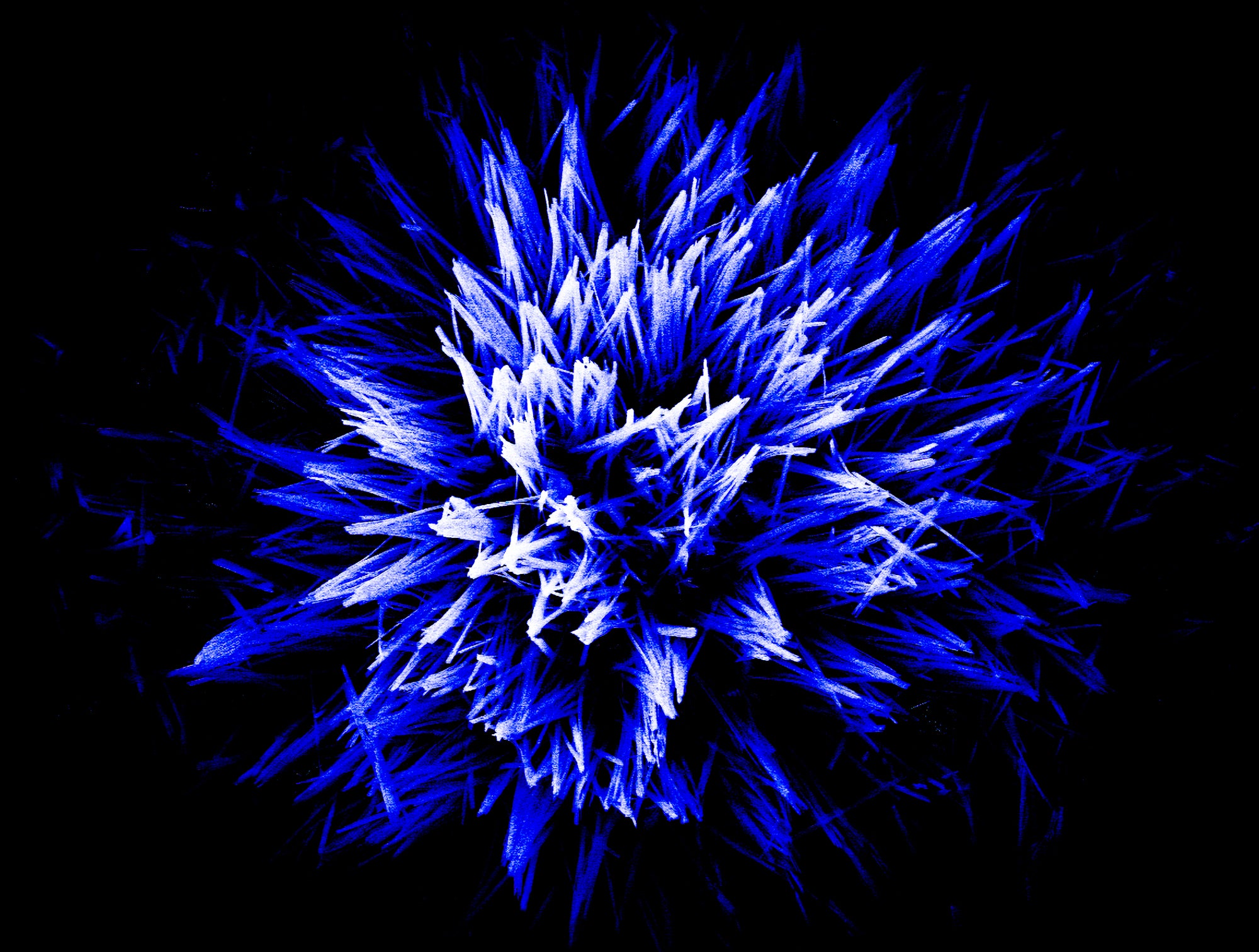
A nanoneedle floral bloom
Name: Arani Mukhopadhyay, Anish Pal, Constantine M. Megaridis
Program: Mechanical and Industrial Engineering
Division: ENGINEERING, MATHEMATICS AND PHYSICAL SCIENCES
Description: As electronic devices get smaller and faster, which requires them to perform at ever growing power inputs, they develop hot spots which are very difficult to cool. Novel wick-free vapor chambers developed in our lab (MNFTL) at UIC work as efficient heat spreaders that can effectively cool high-power electronic devices. Our vapor chambers often incorporate intricate microstructures with hierarchical roughness (as seen here, nanoneedles growing on micro-hills), that leads to manifold increase of surface area from which water can evaporate easily, thereby cooling down such devices and ensuring better device performance.
Honorable Mention - Still Image Heading link

Disabled Nurses: Assets, Not Burdens
Name: Sabrina Ali Jamal-Eddine, Ja’van Carr
Program: Nursing
Division: LIFE SCIENCES
Description: Image description: A brown woman with long brown curly hair, blue scrubs, and a white post-surgical TLSO back brace smiles with her stethoscope pressed against an extended white arm wearing a black blood pressure cuff. This interdisciplinary health humanities research explores ableism experienced by disabled undergraduate nursing students across the United States while simultaneously challenging the ethical dilemma nursing faculty perceive in admitting disabled students to the profession. Despite the Americans with Disabilities Act (ADA), disabled nursing students across the United States disproportionately face discriminatory, systemic, institutional exclusion from Bachelor of Science in Nursing programs as they remain unrecruited, unadmitted, unenrolled, and unretained. As a profession, nursing offers inherently accommodating career pathways such as telehealth, administrative, informatics, outpatient, and research-based nursing. Additionally, disabled nursing students and nurses bring disability-concordance as well as ‘crip wisdom,’ or the knowledge and skills associated with being disabled, which are very useful to patient care. Disabled nurses are assets, not burdens to the nursing profession. This image of a disabled Arab Registered Nurse wearing an assistive device while providing patient care seeks to disrupt the harmful patient-provider dichotomy while illustrating that disabled healthcare providers exist. Image of Sabrina Jamal-Eddine shot by photographer Ja’van Carr.
Honorable Mention - Still Image Heading link
Where the Inkas Met the Ocean
Name: Rosa Varillas
Program: Anthropology
Division: BEHAVIORAL AND SOCIAL SCIENCES
Description: My research is focused on studying the Inka occupation of the coast of Peru and their interactions with the pre-existing groups in the area. To begin my investigation, I utilized drone photography to map out the archaeological site of Puerto Inka, which is thought to be one of the earliest Inka coastal sites with a road connecting it directly to the Cuzco capital. By analyzing these images, I hope to identify any unique features of the site that could shed light on the Inka’s presence in the region, such as architectural styles, construction methods, or utilization of space.
1st Place - Moving Image - Animation Heading link
Mast Cell Histamine Response
Name: Hannah Koffman
Program: Biomedical Visualization
Division: LIFE SCIENCES
Description: The animation video provides visual documentation of the complex immune system response to allergens, highlighting the key role that mast cells play in the process. It is intended to be used as a part of an educational video series, for a high school level audience, on the different aspects of the inflammatory response. The video explores the science behind how mast cells, equipped with highly specific IgE sensors, detect allergens and undergo degranulation to release histamine into the extracellular space. The animation also shows how histamine triggers blood vessels to dilate and leak fluid, enabling other immune cells to quickly infiltrate and fight off the invaders. The animation was created using Autodesk Maya, an advanced 3D animation software, and it is based on the latest research in immunology. The goal of this animation was to create an engaging and informative resource for educators, students, and researchers alike, providing a visual representation of the complex processes involved in the immune system’s response to allergens. The animation will spark interest and promote research in the field, as well as provide valuable information to those seeking to understand this topic in greater detail. The use of animation makes it easier for students to understand and visualize the complex immune response and facilitates the retention of the material in the long term. In conclusion, this animation provides a clear and engaging depiction of our research findings, contributing to the overall understanding of the immune response to allergens.
1st Place - Moving Image - Live Action Heading link
Community Voices for Community Change in McKinley Park
Name: Jenna Pollack
Program: Urban Planning and Policy
Division: BEHAVIORAL AND SOCIAL SCIENCES
Description: Coming to urban planning and policy from a career in arts, I am committed to the integration of cultural, communal, and civic infrastructure. My research is rooted in community-led planning processes, progressive economic development, and grassroots expressions. Serving as the Teaching Assistant and Studio Manager for the Master of City Design program’s 2022 Chicago Charrette, it was important that this approach extend into the way I helped to facilitate engagement with the McKinley Park community. As part of the Studio’s design of three cutting-edge public infrastructure and civic realm projects, I aimed to creatively capture the voice of residents to drive the process rather than those of the students or potential developers. Ultimately, producing a documentary was one of the strategies I employed to reflect back to residents the beauty, complexity, and diversity of voices that drive this work. This documentary snippet frames the lived experience and imagination of two McKinley Park residents – Kate Eakin and Jessica Fong – as they describe the changing industrial development landscape in their neighborhood. The subsequent plan from this process, entitled ‘35th Street Reimagined: Codesigning Neighborhood Improvements with McKinley Park Neighbors’, received an American Planning Association – Illinois (APA-IL) Student Project Award. It can be explored further at www.sites.google.com/uic.edu/mckinley-park-plan2022/
Honorable Mention - Moving Image Heading link
Spoken Word Poetry As Critical Narrative Pedagogy
Name: Sabrina Ali Jamal-Eddine, Ja’van Carr
Program: Nursing
Division: LIFE SCIENCES
Description: A brown woman with long brown curly hair wearing a beige turtleneck bodysuit, blue jeans, and a gold necklace that reads ‘Sabrina’ in Arabic sits on a stool holding her phone while performing a short excerpt of a spoken word poem. Audio description: The speaker’s tone of voice is loud and angry. Drawing from Disability Justice and Critical Pedagogy, this interdisciplinary health humanities research explores spoken word poetry as transformative critical narrative pedagogy in nursing to educate nursing students about disability, ableism, and disability justice. Spoken word poetry is embodied performance poetry that often centers the stories, voices, and narrative-based lived experiences of multiply marginalized people through justice-oriented anti-oppression processes of critical education and liberation. This is a very short excerpt from a spoken word poem entitled “I Wish I Knew How It would Feel To Be Free” which delves into one of Sabrina’s experiences with ableism related to her acquired non-apparent physical disability. This serves as a point of dialogue for discussing mis/trust of disabled folks, non-apparent disability, pathologizing of assistive devices, and ethical breaches that allow for medical malpractice. This (incomplete) except was written and performed by Sabrina Jamal-Eddine and recorded by Ja’van Carr.
Honorable Mention - Moving Image Heading link
Experimental validation of heterogeneous robot planning
Name: Mohammad Safwan Mondal
Program: Mechanical Engineering
Division: ENGINEERING, MATHEMATICS AND PHYSICAL SCIENCES
Description: My research on UAV-UGV cooperative systems for vehicle routing problem (VRP) involves developing and testing algorithms and models for the optimal routing of a team of Unmanned aerial vehicles (UAVs) and Unmanned ground vehicles (UGVs) for tasks such as surveillance, reconnaissance, and search and rescue operations. The objective is to find the most efficient and effective route for the team to complete their task while taking into account various constraints and objectives such as minimizing travel time, maximizing information gathering, and ensuring safe and reliable communication between the vehicles. This research is important because it has the potential to greatly improve the efficiency and effectiveness of tasks that require the use of UAVs and UGVs. By optimizing the routing of the vehicles, the overall performance of the cooperative system can be enhanced, leading to more accurate and reliable data collection, faster response times, and increased safety for both the vehicles and the operators. My submitted video shows a successful validation of a developed framework for UAV-UGV cooperation where a UAV visits a set of mission points by getting recharged from a moving UGV in a small lab scale setup.